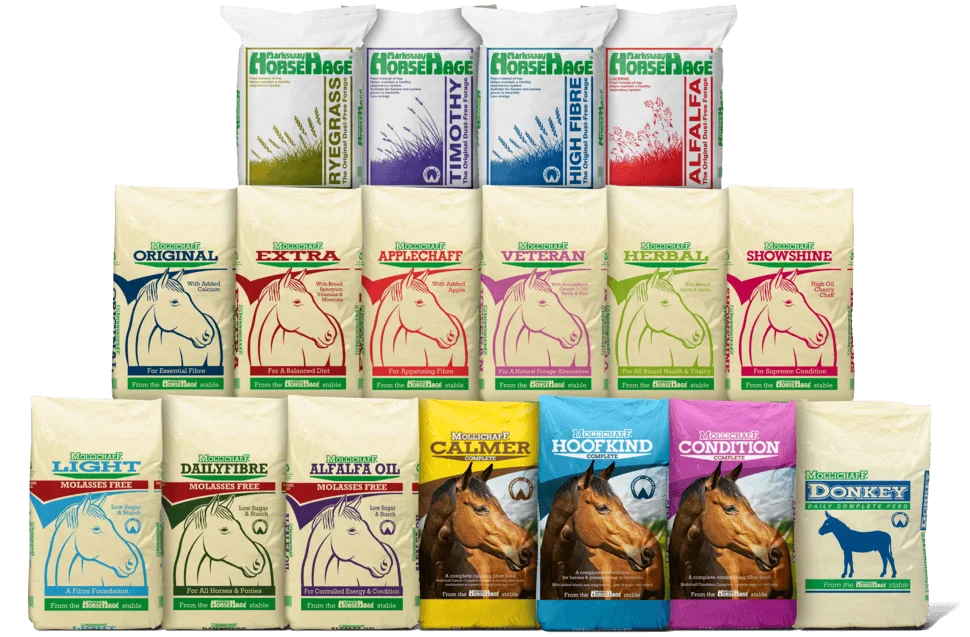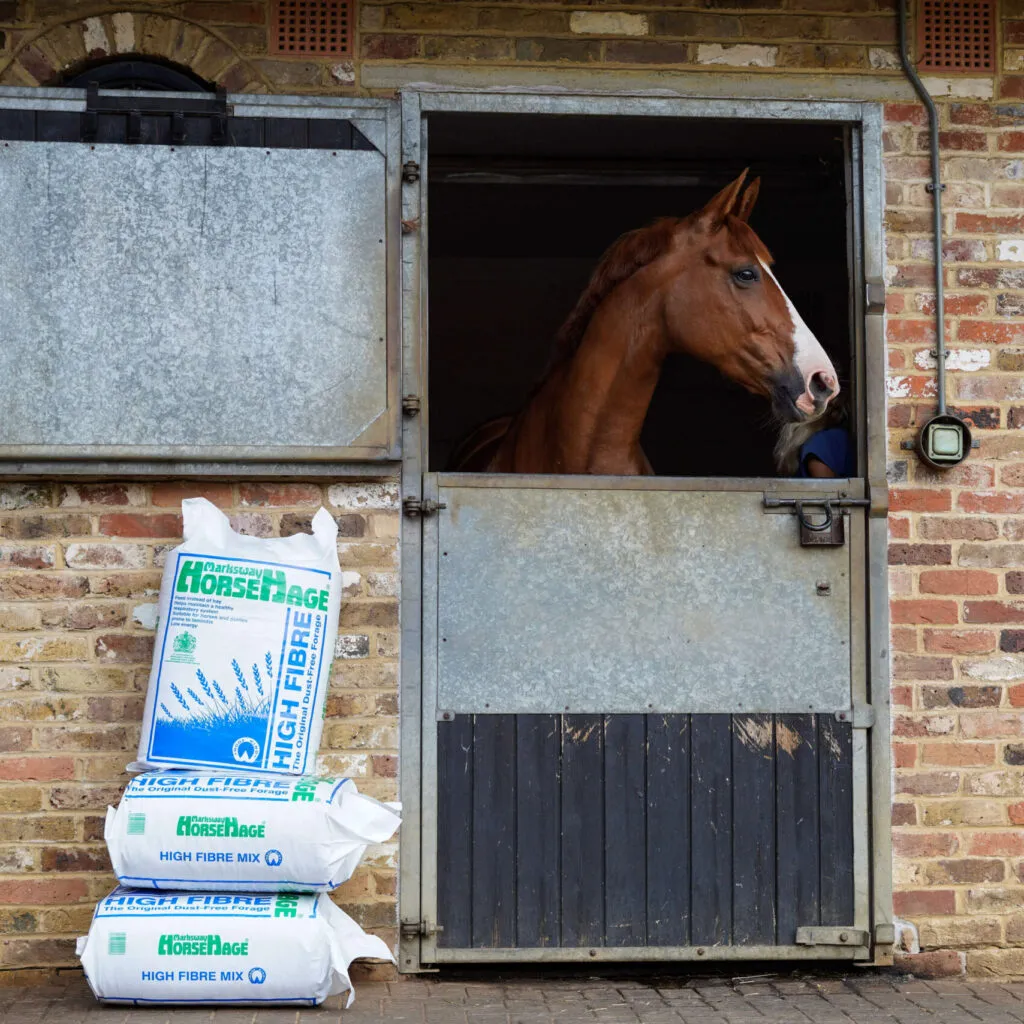
by Sarah Turnbull, HorseHage & Mollichaff Feed Advisor
Hay vs haylage for horses
The type of forage you feed your horse can have a significant impact on their health and well-being.
It is important to understand the differences between hay and haylage, as well as the different types of haylage, so that you can choose the best option for your horse’s individual needs.
What is hay?
Hay is typically cut either from permanent pasture meadow grasses, with a wide variety of grasses and other species (often called meadow hays), or from specialist seed leys with a known composition of grasses, usually ryegrass based (referred to as seed hays).
Usually, the plant material is cut when it has produced the seed head, but is still green, then dried naturally in the field or mechanically in barns.
However, barn drying tends to be less common in the UK. Field drying can often be challenging due to the British weather and the requirement of several days of warm weather to produce the best quality hay.
Hay often has higher levels of dust compared to haylage.
Dust is a mixture of broken-down plant material, fungal spores, bacteria and microorganisms.
Dust in the horse’s environment for example in bedding or forage will adversely impact the horse’s health.
Hay that is baled wet is likely to become mouldy and have increased numbers of fungal spores, which will have a negative impact on the respiratory health and performance of the horse.
Microbial growth in hay baled wet can also increase the temperature which in turn can increase the risk of barn fires.
What is haylage?
Haylage is grass that is typically cut slightly earlier than hay and left to wilt rather than completely dry out like hay.
Haylage has a higher moisture content than hay, typically around 35 -45%. The grass is compressed and wrapped in specialised plastic to maintain the optimal moisture content for the natural fermentation process to occur.
Haylage will retain more nutrients than hay, especially the water-soluble vitamins, and the fermentation process converts the water-soluble carbohydrates (sugars) into volatile fatty acids which are used as an energy source by the horse.
The fermentation process lowers the sugar levels and increases the digestibility of the forage.
Although haylage is wrapped, the packaging can be prone to holes increasing the chance of bacteria, fungi and mould entering the bales.
Careful storage of haylage to avoid punctures to the packaging from birds or vermin, or accidental damage is important to avoid wastage.
Sometimes we hear the owners discussing their forage “I have a lovely haylage it is really dry”.
The likelihood is this is wrapped hay and has not been through any kind of fermentation process, this means the sugar content could be around 8-12% and in some cases higher.
Unfortunately, these bales are sometimes mis-sold and usually at higher prices than standard hay – they are often not as palatable, and may not have the respiratory hygiene and nutritional benefits of correctly fermented haylage.
What types of haylage are there?
Big bale haylage
Big bale haylage is often produced by a local farmer and may vary in quality depending on which farm your purchase it from. You may find that even the consistency at a single farm can also vary.
One of the most important rules of feeding is to make changes to horses’ diet slowly. Therefore, inconsistencies in the forage can disrupt the horses’ digestive system and may even result in digestive disturbances.
Sometimes the farmers plan to make hay, but perhaps due to adverse weather forecasts, end up baling the cut grass, before the grass is fully dry.
They decide to wrap it and call it haylage. Hay is usually cut a little later than grass that is being made into haylage and if the grass is too dry the natural fermentation will not occur.
Big bale haylage is made in a similar way to semi-wilted bagged forage, but in bales weighing up to half a tonne, and rather than being bagged directly from the field, the bales are wrapped in several layers of plastic.
Due to their size, the bales are difficult to handle and impractical for most horse owners as once opened the bale needs to be consumed in 3-5 days.
They also tend to be higher in moisture and more difficult to compress, leading to poor fermentation.
This means the quality and consistency will reduce further. Sometimes, large quantities of the forage must be thrown away as it is unpalatable or mouldy.
If you are competing with your horse, you need to make sure your feed doesn’t contain Naturally Occurring Prohibited Substances (NOPS) otherwise you risk being disqualified.
Many big bale producers will not be BETA NOPS certified. If you are unsure you can ask the producer for a copy of their NOPS certification.
Rebagged small bale haylage
Rebagged haylage, as the name suggests, is big bale haylage that has been later rebagged into smaller bales.
The big bales are unwrapped and fed through a machine that breaks down the bale and forms it into a solid mass which is then compressed into a bag and sealed.
The main advantage for horse owners is that the small bales are more practical.
A bale is usually about 20kg and you should be able to fit a few in the back of your car, or even more in your horse lorry if you’re away from home for a few days.
The individual bales can be opened and fed separately to your horse, leading to less feed wastage too. However, there is more plastic wastage overall as both the big bales and the resulting small bales require plastic packaging.
Unfortunately, there are some disadvantages for horse owners too.
Since the big bale needs to be unwrapped and processed before being rebagged and sealed, there is a heightened risk of dust contamination and secondary fermentation due to being exposed to air during the process.
The shelf life is also reduced, meaning some producers will use mould inhibitors or other chemicals or flavourings to improve the shelf life and palatability.
As mentioned previously, if you are competing with your horse you need to make sure your feed doesn’t contain NOPS. If you do not see the NOPS logo on the packaging or the producer’s website, it’s unlikely that the haylage is NOPS certified.
Direct-to-small bale haylage
Direct to small bale haylage avoids the big bale stage entirely.
The grass is baled into small bales directly in the field and then packaged into sealed bags moments after.
When done correctly, this method leads to the highest quality small bale haylage on the market.
Since there is no need to break down and rebag big bale haylage, the risk of dust contamination and secondary fermentation is greatly reduced.
Additionally, the individual bales will naturally have a much longer shelf life (up to 18 months) and therefore don’t require any mould inhibitors or other chemicals or flavourings to improve the shelf life and palatability.
For horse owners, feeding a direct-to-small bale haylage means you get the advantages of a small bale haylage without the disadvantages of being rebagged big bale.
How is HorseHage made?
HorseHage was created in the 1970s as a great solution for respiratory issues experienced by performance horses and caused by the dust that occurred in other forages.
Innovating the direct-to-small bale method to produce consistent high-quality dust-free haylage, HorseHage is the only major producer of haylage that uses this method.
HorseHage comes in four varieties Ryegrass, High Fibre (made from selected ryegrasses that have been allowed to mature to maintain the high fibre, low protein content), Timothy and Alfalfa.
The fields are sown with specific grass and lucerne lays and monitored throughout the season until they are ready to cut.
When the grass is cut, it is allowed to wilt in the field, but not fully dry out, as some moisture is required for the natural fermentation process to occur.
The grass is then baled directly into small bales and packaged.
Although traditional haylage is wrapped, the plastic is prone to holes. HorseHage’s packaging is double-lined to reduce the risk of bacteria, fungi and mould gaining access to the forage and causing spoilage.
The gases produced during the fermentation process are able to escape through the semi-permeable outer shell, however, air is unable to enter the bale.
The production, preservation methods, nutritional value, and hygiene content are considered when making HorseHage to ensure it is the best quality.
For further information about different types of forage, check out this guide.
Why feed HorseHage to horses?
Nutrition
Many forages are not accurately tested for feed value, making it difficult to maintain a consistent diet for horses and may affect the horse’s performance.
HorseHage performs nutritional analysis every season to ensure it’s meeting the nutritional requirements that are expected.
Check out this chart for the typical nutrient analysis of HorseHage
There are four varieties of HorseHage, all with different nutrient levels, which means there is something suitable for most horses and ponies.
However, it is important to consider all elements of the horses’ diet when deciding what to feed.
Many horse owners look at forage and bucket feeds as 2 separate parts. For a balanced diet suitable for the individual horse the whole diet must be assessed, taking into account medical conditions, weight, condition, age, size, temperament, workload and rider capability.
Learn about the benefits of a high-fibre diet for horses and how to feed HorseHage.
BETA NOPS Certified
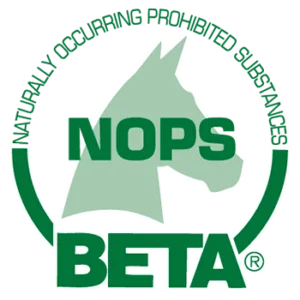
If the horse is competing at a level where testing for prohibited substances is likely, it is important to ensure all forage/bucket feeds/supplements carry the BETA NOPS accreditation, easily spotted with the logo on the packaging.
Prohibited substances are defined broadly as any substance which can exert a performance-enhancing effect on a horse.
A naturally occurring prohibited substance (NOPS) is one that is either present naturally in certain ingredients or occurs as a result of cross-contamination during processing before arriving at the feed manufacturer’s facility.
The BETA NOPS code requires manufacturers to evaluate the risk of NOPS contamination during every step of the sourcing, storage, transport, and manufacturing processes for each product and to design their quality management systems in line with the risks identified.
For professional riders, a positive blood test can have devastating effects on their career, so this is an extremely important consideration.
If you’re unsure if a product is BETA NOPS certified you can call the company and ask for a copy of their certificate.
FEMAS Certified
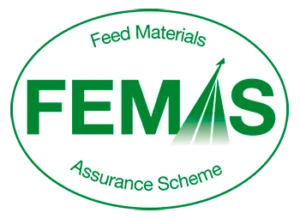
HorseHage is certified by the Feed Materials Assurance Scheme (FEMAS).
The FEMAS Standard is applied to feed ingredients used in the production of animal feed and ensures that HorseHage is produced from specially grown grass and alfalfa leys with high regard for feed safety, consistent quality and full product traceability.
This means you can feed HorseHage confidently, knowing every precaution has been taken to ensure it is safe to feed.
All HorseHage products come with a 100% guarantee.
The haylage of choice for top riders and teams
Top riders and teams need to be confident that what they’re feeding their horses will facilitate their best performance.
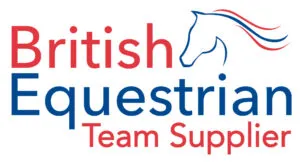
HorseHage has been chosen by the British Equestrian Team and has been fed to the team’s horses at every Olympic Games since Los Angeles in 1984.
The following top riders also choose to feed HorseHage for optimum performance:
Want free nutritional advice?
Our friendly and knowledgeable team is available on weekdays from 9am to 5pm.
Give us a call at 01803 527274 or send an email to sales@horsehage.co.uk

